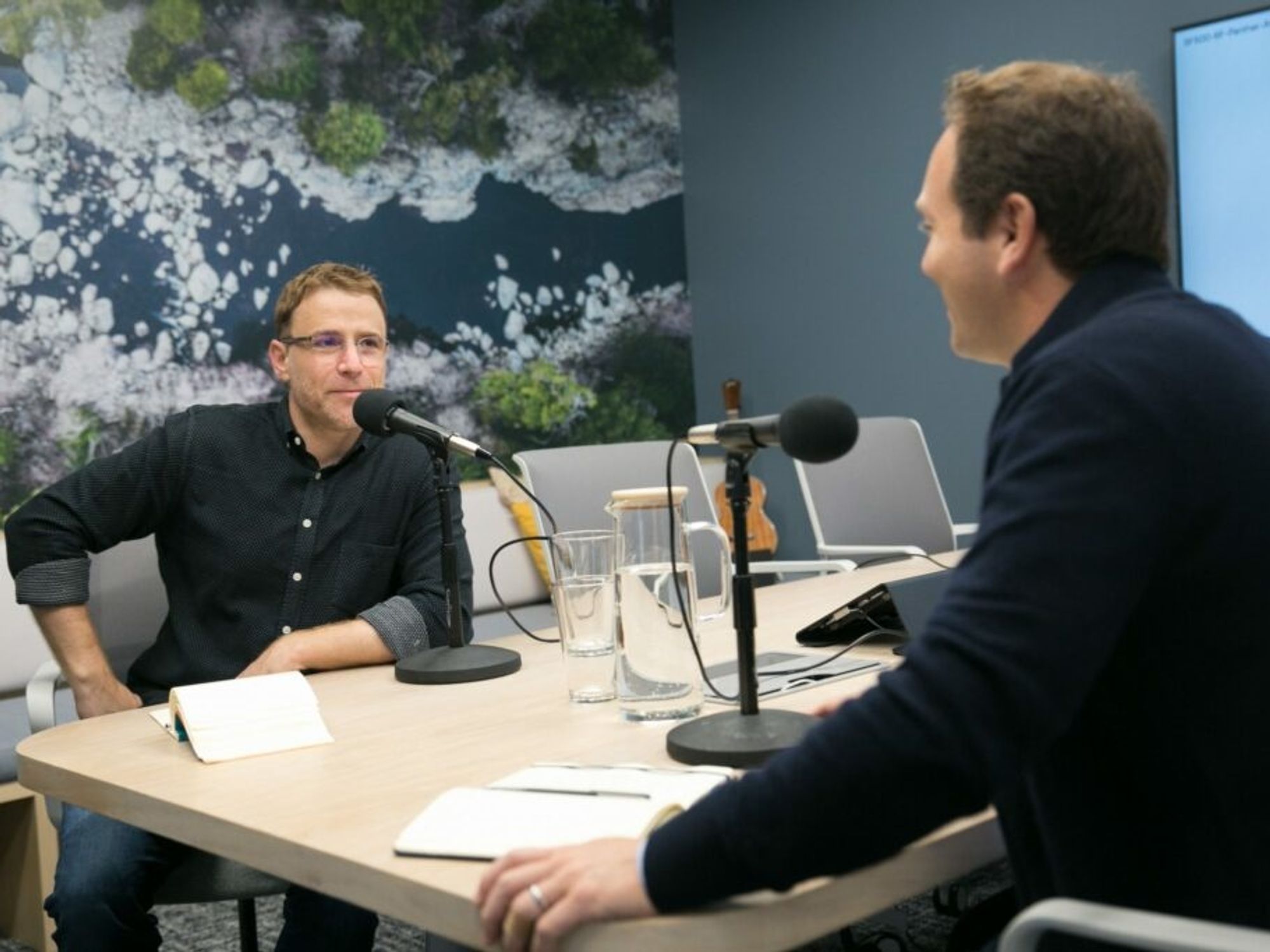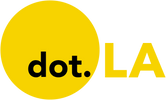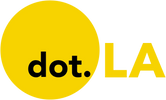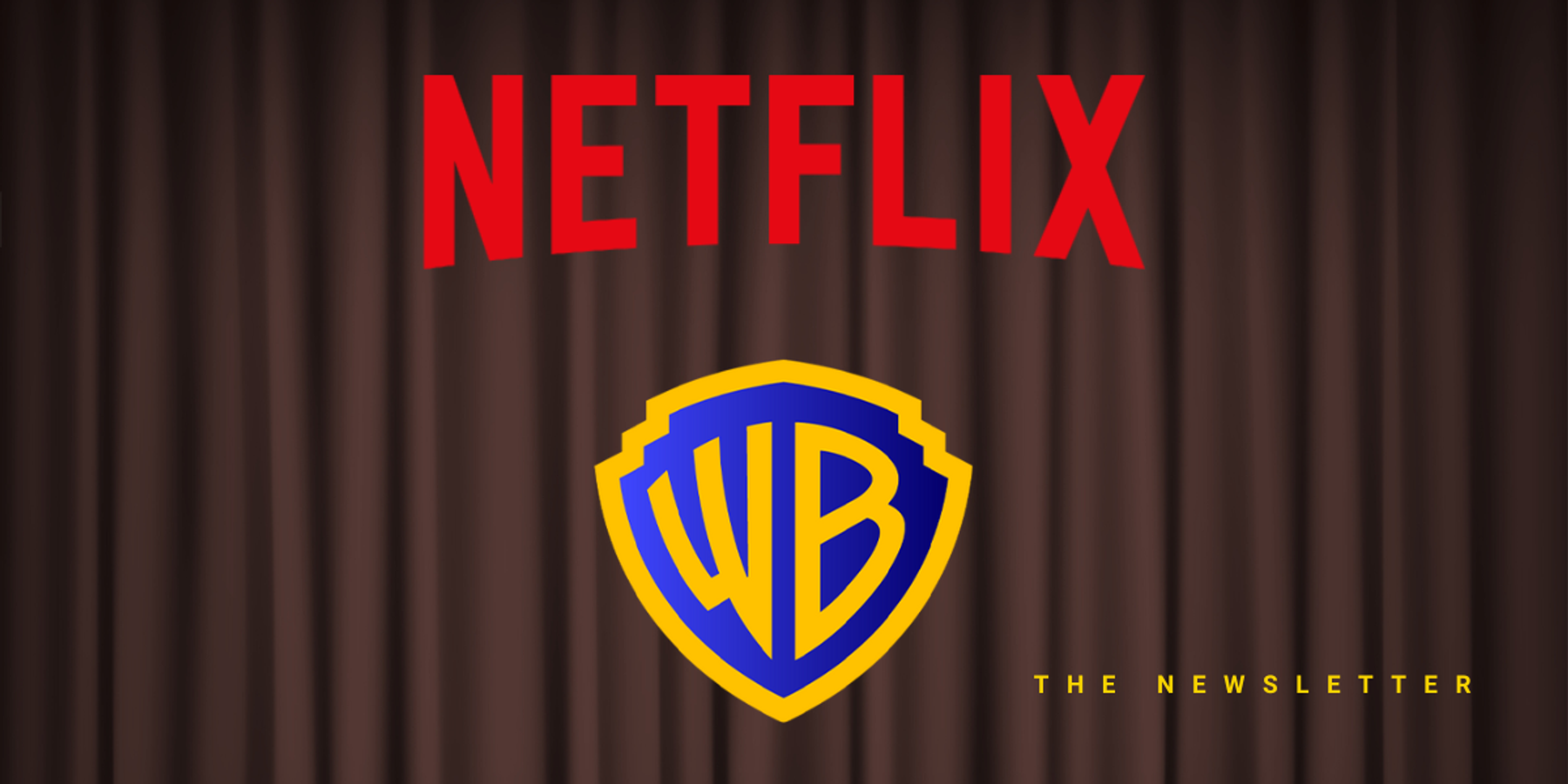Slack’s Stewart Butterfield: Collaboration Means Leadership From Everywhere
Spencer Rascoff serves as executive chairman of dot.LA. He is an entrepreneur and company leader who co-founded Zillow, Hotwire, dot.LA, Pacaso and Supernova, and who served as Zillow's CEO for a decade. During Spencer's time as CEO, Zillow won dozens of "best places to work" awards as it grew to over 4,500 employees, $3 billion in revenue, and $10 billion in market capitalization. Prior to Zillow, Spencer co-founded and was VP Corporate Development of Hotwire, which was sold to Expedia for $685 million in 2003. Through his startup studio and venture capital firm, 75 & Sunny, Spencer is an active angel investor in over 100 companies and is incubating several more.

Stewart Butterfield is the co-founder and chief executive officer of Slack, a collaboration hub beloved by more than eight million daily active users. In this episode, Spencer joins Stewart at Slack's San Francisco headquarters to discuss their recent partnership with Atlassian, Slack's unique origin story, managing through growth and adversity, and how Slack is fundamentally changing communication at work.
Press Play to hear the full conversation or check out the transcript below. You can also subscribe to Office Hours on Apple Podcasts and PodcastOne.
Spencer Rascoff: Today I'm in San Francisco in the offices of Slack, and I'm with Butterfield. Stewart, thanks a lot for having me. It's great to have you here.
Stewart Butterfield: My pleasure.
Rascoff: So, congratulations, first of all. The timing of this worked out great. There was some huge news that came out about Slack and HipChat. Why don't you just share the news, and we can talk about it.
Butterfield: Sure.
Rascoff: What did you announce?
Butterfield: We've been working with Atlassian for a couple of years now on general partnerships. So, we make Slack the hub for collaboration or messaging for work or however you want to characterize it, and they make Jira, which is a really popular bug and issue tracker ticketing system used for all kinds of things. They make Confluence, which is like a Wiki/knowledge management tool, Bitbucket, source code control kind of like GitHub, and a whole bunch of other products.
And they also had a product called HipChat traditionally, and then about a year ago they introduced a new product called Stride which was their replacement for HipChat, and both HipChat and Stride were competitive with Slack. We still worked with them really well because we collectively had, at this point, hundreds of thousands of organizations who were using Slack with at least one Atlassian tool, like — I forgot to mention — Trello, task management application.
And we had no problem competing with them and cooperating, and they didn't either, but I think they came to the realization that the resources that they were investing in those products was probably better invested in their core products, which are, you know — in terms of market share, in terms of revenue — are much, much larger and go deeper on the partnership. And I think that was a really smart move, you know, very well-rewarded by the market and analysts. I got a lot of congratulatory emails saying that was brilliant, and I said, “We executed well, but I've got to give them credit for the idea." And I think it was a really unusual move for someone to make.
Rascoff: Yeah. I've never seen — so, what they basically did was they said they were gonna wind down HipChat and sell you the customer list and the IP —
Butterfield: Mm-hmm. Not even the customer list.
Rascoff: OK.
Butterfield: We're working together with them. So, we built a whole migration tool. They're messaging all of their customers, and definitely no one is being forced to migrate, but we wanted to extend the same pricing that they had to all those customers and just make it as easy as possible for people to move over.
I think there's a long history — if you go back to, like, what Microsoft looked like to IBM in 1982, or what Google looked like to Microsoft in 2001, or what Facebook looked like to Google in 2006-2007 — of a smaller, focused start-up with traction versus a larger incumbent that has multiple lines of business, and there's just a real advantage, I think, that you get in terms of the experience you can provide to customers and the kinda clarity and focus. So, I think there's — that's not always true, sometimes the big company squashes the smaller one, and in fact maybe that's more often true — but there's definitely a handful that make it out. So, I mean it feels good, but it doesn't feel good because that came at the expense of someone else, you know.
Rascoff: Right.
Butterfield: That feels good because we have thousands — tens of thousands of customers tweeting stuff, like, every day, posting to Facebook, telling their friends, insisting at their new employer that they evaluate Slack 'cause they used it at their old employer because they really like it.
Rascoff: I get the sense that the culture is not a competitor-focused culture, it's more of a persona-focused culture, customer-focused.
Butterfield: Yeah.
Rascoff: Employees come here every day trying to do the right thing by your users, and sort of whatever happens in the competitive landscape happens. Is that fair to say?
Butterfield: Yeah. No one will ever get fired because they were too good to a customer.
Rascoff: Right.
Butterfield: Including “good" in the sense of lost revenue opportunities or deferred revenue for us. We really believe in the long run — and I want to be doing this for the next 20 or 30 years, and, you know, it'd be great if the company existed for a couple hundred thousand years, couple hundred million years, who knows. In the long run, the measure of our success will be how much value we created for our customers. 'Cause you can always be the exploiter, you know, you can always be extracting more value than you can create but not for long. That just doesn't work for the universe for very long.
Customers are not gonna consistently choose Slack every year, every year, no matter what happens in the marketplace, no matter what other products arise, what other systems, if we're just trying to suck more money out of them and not make it actually something that's worth their while. I mean, the ideal case is for every dollar they spend with us they're getting back $10 or $100 or who knows in value. So yeah, we're definitely not focused on what competitors are doing, we're aware — we actually have a saying inside, “Competitor aware, customer obsessed."
Rascoff: I like that.
Butterfield: Yeah.
Rascoff: So, my first start-up, Hotwire, was very competitor focused. We were really focused on Priceline, and Zillow, my next start-up, is not so competitor focused. We're really consumer focused and persona focused. And it's a much more inspiring place to work when you're persona focused and not competitor focused. It's a little bit — I don't know, it's a little bit hollow, almost, to be overly competitor focused.
Butterfield: Yeah. I think it's easier for us to take that position than many other companies. If you're one of, I don't even know, let's say 1,200 restaurants in SoHo, in New York.
Rascoff: Right.
Butterfield: People have a lot of choice, and they're also not gonna go to your restaurant every time. And for Hotwire and most other travel sites, it's like it's a purchase-by-purchase decision, and people might have three tabs open —
Rascoff: It's much more zero-sum, yeah.
Butterfield: Yeah, and they're looking all over the place. Whereas — and certainly people can evaluate all kinds of software that they might use in the enterprise, but the commitment to actually make a purchase or invest is, like, something that happens over the course of months, you know.
Rascoff: Right.
Butterfield: And it's a much bigger just in terms of, like, literally the calories, like the glucose burned in their frontal cortex of the human beings who are doing this — is, like, a million times greater 'cause you have to shift the behavior of, you know, depending on the size of the company, dozens of people, hundreds of people, thousands of people, against habits they had formed over, like, the last decade or two.
Rascoff: So today, Slack is incredibly successful, of course, riding high from this recent announcement, but that's just a proof point. You know, so we don't need to dwell on it. It wasn't always that way. So, Slack rose from another company that was not as successful, so can you describe the founding story and sort of the early days of how Slack got started?
Butterfield: Sure. Here is the fastest possible version. Back in 2002, in, like, the really dark days — post-9/11, post-WorldCom and Enron, post-dot-com crash, NASDAQ down 80 percent, S&P 500 down 65 percent — we started a web-based massively multiplayer game company, which was not very well-timed. That ended up turning into Flickr through other means. Flickr got bought by Yahoo. A group of us went to go work for Yahoo.
Nine years — or sorry, seven years — later, 2009, we decided to try it again. We started another web-based massively multiplayer game company, which also failed. After about three and a half years, we had 45 people working on it and a pretty eclectic group because there's, like, some really serious, hardcore back-end engineering challenges, but there's also writers and artists and animators and musicians, and there is, of course, a business operations team and customer support.
And over the course of those three and a half years, we had started using a pretty ancient Internet technology called Internet Relay Chat, or IRC, which predates the web by a couple of years. And over the course of that three and a half years, just, like, one at a time and a pretty jury-rigged, hacky fashion, fixed the things that we thought were really annoying, like the kind of — the most irritating problems and challenges we had around internal communication or, conversely, the opportunities for improvements that seemed most obvious.
And then over the course of these years, we had this system for internal communications where it was a real virtuous circle; the more people paid attention to it, the more information we would route into it.
Rascoff: What did you call it internally?
Butterfield: It didn't even have a name. I think this is one of the reasons it had such incredible product market fit is there was, like, no ego involved in this. There was no speculation about what a user might want or like. This was just, like, how can we spend the minimum number of minutes to fix or improve this and then go back to what we were supposed to be doing and —
Rascoff: And it was just used for employees, the 45 employees that were working on this game that was not finding traction in the marketplace.
Butterfield: Yeah. Like, I don't even know if you — or if I did an interview at that time and someone said, like, “How do you all work?" I probably would have mentioned it, but it wouldn't have seemed very significant. At the end of the process, though, when we decided to shut down the game, we realized, “Hey, we would never work without something like this again, and probably other people would like it."
So, we had this blueprint which we executed against, and as soon as we put it in the hands — I mean not as soon as, 'cause the first couple customers are almost impossible to get. We had to beg our friends to please try it, please try it. 'Cause one of the challenges for Slack and things like it is you can't unilaterally decide — I mean, you maybe can 'cause you're the CEO — but one can't typically unilaterally decide that they're gonna use Slack to communicate with their team; everyone has to agree. Whereas somebody like, say, Dropbox — I've been paying for Dropbox for seven years or something like that. I'm a very, very happy customer — I didn't want to have to back anything up. I have multiple computers, seemed like a great solution. I just did it, but you can't do that with Slack, right? You need to get at least two people —
Rascoff: Right, you need buy-in from the rest of your —
Butterfield: Yeah, yeah.
Rascoff: Right.
Butterfield: And that needs to happen not, like, sequentially over the course of a year but more or less around the same time, and it's disruptive 'cause it's a change to how you communicate internally. So, I don't want to underplay that as a challenge. But once we did get groups using it, we found they just kept on using it, and the usage inside those companies grew, and people were very happy. And the same thing happened for them as happened for us: the more information you routed into it the more attention people paid, and the more attention people paid the more information you added into it, until, like, finally there was one kind of focal point for where work happens across the whole organization.
Rascoff: So, when you pivoted this gaming start-up to an office collaboration technology start-up, were there some people that either said, “Hey, I'm not in on that next mission," or people that weren't a good fit for what you needed?
Butterfield: Oh no, I mean — the actual shutdown — I'm glossing over the trauma.
Rascoff: OK.
Butterfield: It's pretty brutal. I mean, there was 45 people, we laid off 37 of them.
Rascoff: OK.
Butterfield: And, you know, for entrepreneurs in the audience who have been doing it for a while I'm sure they'll recognize the ups and downs. But I mean, first of all, it's humiliating personally 'cause, you know, I put a lot of my own credibility on the line, and I talked to press and investors and saying we're gonna do this and that, and then it doesn't work. And that feels bad for me individually. But much worse is the fact that I convinced most of these people to come work at the company and to give up some other opportunity that they had.
Rascoff: Right.
Butterfield: In some cases, to move to a different city. I mean there was a moment when I was announcing it internally where I kinda was just looking around the room while I was talking. First of all, I started crying almost immediately, before I got the first sentence out, but then I, like, locked eyes with one guy who, just a couple months ago had moved from a different city, away from his in-laws who were helping take care of his at that point, I think 18-month-old daughter and buy a house in this new city. And then I was telling him, “Sorry, you don't have a job anymore."
So, happy ending on that one because we hired him back about six or nine months later and he was a very early Slack employee and happy. But yeah, I mean, we don't have a big need for musicians at Slack or animators or level designers or a lot of the disciplines. So, that was, like, a — it was a pretty dark time for a while and took us a few months to — because we had money left, we were able to do it in a relatively elegant way, so a couple months to kinda clean it up.
Rascoff: Right.
Butterfield: So, offer our customers their money back, or we could donate it to a charity on their behalf, or we could keep it, to put a lot of effort into making sure that people got other jobs. We built, like, this whole website with everyone's resume and portfolio, and we did some interview coaching and wrote reference letters and got everyone else a job.
Rascoff: This was in Vancouver mostly.
Butterfield: This was, yeah, Vancouver and San Francisco, but Vancouver was the larger office at that time, and then — so, that's the end of 2012, beginning of 2013, and we start making Slack middle of 2013. We had started using it ourselves and we tried to get some friends to use it. August of 2013, we did private beta, which we called a “preview release" 'cause we didn't want people to think it was flaky. February of 2014, so four and a half years ago, we officially launched it and started charging and stuff like that. So, it was really fast, like 14 months.
Rascoff: Right.
Butterfield: And by the time we launched it, there was about 15,000 daily active users, and the teams were really sticking and there was just — like I said, this incredible product market fit out of the gate, which, to be honest, I think has propelled us to where we are today, four and a half years later.
Rascoff: I mean, managing through adversity for a leader but also for the whole company frequently makes the company all that much stronger and better. Probably somewhere in the Slack DNA, and definitely in your management DNA, are lessons learned from that period.
Butterfield: Yeah.
Rascoff: As the company has scaled to today — to 1,000 employees, eight offices — what are some lessons that you've learned as a leader through that growth period? How have you changed as a leader and as a manager? You know, what are some things that other listeners can learn from having managed through that growth?
Butterfield: It's more like what hasn't changed? I mean, I have been making software for about 25 years, like professionally, and I'm 45 now, and I'm good at product design, good at software development. I'm probably not gonna get any better at this point, not because I'm so great at it but just because, like, now I'm relatively old, and I've been doing it for so long that if I was gonna get better it would have happened in the last 25 years. And I'm sure I have other significant skills as well, but I feel like that was the strength in my career that got me to where I am, and now that's largely irrelevant. How good — I mean, I'm sure —
Rascoff: Because you have a team that's doing the —
Butterfield: Yeah, 'cause there's 1,200 employees.
Rascoff: Right.
Butterfield: And I'm not gonna make any — you know, like, I could make 10 basis points and, like, one-tenth of a percent worth of the significant decisions on the product development side, and hopefully I make a contribution on strategy, but my job is just completely different, and it took me a long time to figure it out. And I'm sure I wouldn't have said this to you at the time, but if you asked me two years ago what my job was, I would have thought inside my head, very secretly, only to myself, that my job is to be smarter than everyone else and to make all of the really important decisions.
And I didn't mean that, like, coming from an egotistical place, I just felt the pressure of, like, I need to be able to approve anything that's happening. I need to be able to, like — when there was an irreversible, very significant decision for the company, I had to be the one to make it, which, you know, I think actually is still a little bit true today. But when there was irreversible-but-unimportant decisions or reversible-but-important decisions, I didn't need to be the one making those.
So, it took me a long time to figure out what the job actually was, and to me there's three components. So, one, set the strategy and vision for the company, which sounds very lofty, but it isn't super time consuming. We had a great vision out of the gate. We had a great strategy out of the gate. Like, we haven't changed our pricing. In fact, we have set the — the pricing was proposed before we even started developing Slack, and we haven't changed it, and maybe there's better pricing, but it must have been pretty close 'cause it's working.
And the kind of — the positioning we put ourselves in, which is we want to build up to the edges of other software but not necessarily compete with them. We don't want to make document-editing tools, we're not gonna make calendaring tools, we're not gonna make, like, a bug or issue tracker, but we want to make your experience at each of those tools which you already use better because you use Slack.
The second thing is kind of a basket of governance, administrative, supervisory duties, and we have a great GC, we have a great CFO, so that actually doesn't take that much of my time either.
Which leaves a third bucket, which should be almost all of my time, which is ensuring that the performance of the organization, as a whole, is as high as possible. And I didn't think about that as my job, and because I didn't I also didn't delegate that. So, I think we were in a position a year ago, and I think we're still working out of this, where most of the executive team was making most of the decisions, you know. We would spend time, collectively, looking at spreadsheets where each row was a thing that someone was working on and saying, “Is this thing higher or lower priority than that thing? Is it the right team working on it?" And that actually would be fine at 100 or 200 people — it doesn't work at the scale that we're at now, and it's certainly not gonna work at the scale that we're gonna be at at a year and a half or two years from now.
Rascoff: So, setting the vision, but most importantly up-leveling the organization. A lot of that is around motivation, communication, employee comms.
Butterfield: Yeah.
Rascoff: So, the culture at Slack is — it seems very similar to ours. I mean, you have this phrase, “Work hard and go home." What does that mean, and how would you describe the culture here?
Butterfield: So, yesterday I did a new hire welcomes — I do, like, every two weeks — it's like the batch of people who started, and I tell them about that. I don't really actually know if we have it up at our new office, but we will at some point — we definitely had it up at our old office. And I say we had this thing up on the wall that says, “Work hard, go home." Pause, beat, beat. Everyone understood the “go home" part, and everyone laughs.
The work hard part — the point of the whole thing was we want to be able to hire all kinds of people.
Rascoff: Yes.
Butterfield: And some people got kids, and they can't stay till 8 p.m. or 9 p.m. or 10 p.m. Some people have other stuff. They're active volunteers in their community. Their church is important to them. They have hobbies that are significant. And if we can be disciplined, professional focused while we're at the office and really take the best advantage of those, I don't know, four to maybe six hours of really creative, kind of focused intelligent work, then we could all just go home earlier and do other things and rest up and kind of be prepared to do this for years and years — as opposed to play foosball for 45 minutes in the middle and then have a two-hour lunch and spend a lot of time talking about TV shows or going to karaoke that night or whatever it is. That was really important to us.
It took me awhile, until really recently, to think, “You know, we have mission and vision, strategy — we have values," but the thing that became most significant for me in thinking about what kind of culture we wanted to build were these four attributes that someone else mentioned to me, a guy named Suresh Khanna, who last I heard was the CRO at AdRoll, a retargeting company. And I was going for a walk with him once, and he mentioned just in an offhand way that he looks to hire people who are smart, humble, hard-working and collaborative. And for some reason that combination, that phrase really stuck with me.
So, like, a year or maybe two years later, I'm not even — I guess probably two years later, I realized, “Wow, that's, like, a really magical combination." And it's not that those are four important attributes and hopefully you have at least one of them as a strength but those in combination. So, you have probably worked with people who are smart and hard-working but neither humble nor collaborative, and there's certainly an archetype that comes to mind when I say that. Conversely, people who are collaborative and humble but neither smart nor hard-working — another different archetype that comes to mind.
Rascoff: Right.
Butterfield: And that's the thing that we want to cultivate. So, smart in the sense of being not high IQ, although that's a bonus if you have it, but oriented towards learning.
Rascoff: Growth mindset.
Butterfield: Yeah, and realizing that your intelligence and creativity are relatively precious things, and if you're going to be spending mental energy on something it shouldn't be something that is routine, that could be made into a checklist, that is kind of — like, there's no point trying to remember that stuff. Computers are relative to humans, perfect at remembering things. And humans are relative to computers; basically, we don't remember anything. Like, we don't — literally nothing. I don't know who I am, where I am, why we're in this room, like, just no memory. Computers can do arithmetic 100 trillion times faster than human beings — and by the way, with perfect accuracy — whereas no matter how good you are at doing math in your head, you're gonna get things wrong once in a while. So, I mean, those are kind of obvious ones. But how quickly can you improve the way that you work, and how steadily can you improve the efficacies? That's smart.
Humble is pretty obvious. Hard-working is pretty obvious. Although I have to point out that humility is kind of a fundamental one in the sense that being smart like that — understanding when you make a mistake and figuring out how to improve it — requires an element of humility. But the one that I think is gonna be least well understood is collaborative 'cause it's a pretty open word. It has a lot of connotations. It's kind of — it's difficult to know what someone means when they say that this person is collaborative, and here we mean something really specific.
Rascoff: That's very hard to evaluate in an interview as well.
Butterfield: Yeah, yeah, it is. So here, we don't mean like meek or submissive or deferential. We don't mean like you have a tendency to go along with what other people want, which I think is what comes to mind when people say “collaborative," at least sometimes. It's kinda the opposite.
But the difference between the best and the worst performing teams, I think, is much, much wider. Like 100 times wider than the difference between the best and the worst performing individuals. So, as long as you're hiring people who are basically competent, you're not hiring, like, completely incompetent people or, like, a bunch of thieves or something like that. You're gonna have better and worse employees, and better typically means not so much they have more talent at fulfilling the tasks — like their role-specific function, like they're better at Excel than the other people in finance — but that they elevate the people around them.
Rascoff: Right.
Butterfield: That they're an important contributor. They're kind of glue for the team. They drive more clarity and alignment. They give good feedback, and they're receptive to feedback and a bunch of other stuff. You think about, like, people that you've had to fire over the course of your career, or people you know of got fired — people do get fired for incompetence sometimes. The overwhelming majority is they didn't work well with other people.
Rascoff: Right, personal issues, yep.
Butterfield: Yeah.
Rascoff: In their relationships.
Butterfield: So, going back, the collaborative sense here is the opposite of those meek, deferential, submissive — it's leadership from everywhere. It's that you take individual responsibility for the health and performance of this team. So, when there are problems you help clear them up. When there is, like, low trust you help drive up trust. When there is a lack of accountability, when there's a lack of clarity around goals or objectives, you take responsibility for driving those up, regardless of who you are. So, I don't even mean just, like, the manager — I mean everyone.
And if there's a real, deep commitment across the organization to improve the performance of the team, everyone as an individual is better off, 'cause would you rather work on a high performing team or a low performing team? And obviously the whole company is much more successful as well.
Rascoff: I feel like I am a much better CEO today in my mid-40s than I was 15 or 20 years ago, because I agree with everything you just said, and I think it's super important, and when I was in my mid-20s I did not.
Butterfield: Yeah.
Rascoff: I didn't understand any of that.
Butterfield: Yeah. Well, I'm — good news, I'm mid-40s as well and would say exactly the same thing. Yeah, 'cause there's a real tendency to believe that it is, like, the heroic contributions of one genius software engineer or, like, one amazing marketer or something like that, and obviously individual contribution matters a lot, but —
Rascoff: Well, you know, it's nice. I mean, your product also speaks to this, right? Your product is about team collaboration, so it's obviously embedded in the culture of the DNA. As is sort of, like, you know, LinkedIn takes really seriously all these issues because the product is about that — it's about working well with others and collaboration and kind of being your best self at work, and Slack likewise has, you know, the product is that vision. But that's your philosophy background coming through, huh?
Butterfield: Yeah, it definitely is. There's actually one more kind of higher level thing that's going on, and that's over the last 30 years the tools for people to get their individual work done have improved dramatically. So, you imagine, like, how a recruiter gets stuff done in 2018 with LinkedIn, with an applicant-tracking system, you know, with tools to check their — well, resume scoring but also job description, language checkers and all this kind of stuff. Compared to walking into an office building and, like, with a pad of paper and writing down the names of all the companies and then going back to your desk and start making phone calls. Or a salesperson who has a CRM and has marketing automation tools and has lead scoring and has LinkedIn sales navigator, software engineer, you just go through the whole list.
Rascoff: And so, because they have more software to help them be more effective at work, what? Collaboration is more important?
Butterfield: Yeah. I think collaboration becomes the limiting factor.
Rascoff: Why? Oh, I see.
Butterfield: So, you think about it from your perspective, as CEO, if you could hire a magic consultant who would come in and through, like, GTD, time management, life hacks, whatever, would make everyone 10 percent more effective at the completion of their individual tasks, which is a significant component of their work, obviously. But people spend at the low end 30 percent of their time and at the high end 100 percent of their time on communication.
So, if you could have that 10 percent improvement in individual worker productivity, or the same magic consultant would drive a 10 percent increase in shared consciousness, like, knowledge of what people across the organization are doing, or 10 percent better understanding of goals, 10 percent more alignment. I mean, those things are harder to measure perhaps, but obviously more significant 'cause more incremental improvements in individual worker productivity are probably not gonna result in as much of a net change because nothing has happened over the last 50 years, with one exception: to improve the way that we communicate and the way we collaborate and the way that we share knowledge and the way that we get to that point where the team is working really well, and that's email.
And mail was a very, very significant step compared to, you know, mimeograph machines and taking paper and rolling it up into a little tube and sticking it into a cubby or interoffice mail or any of those kinds of things. But I think there is a second really significant change that we're part of — and by the way, if this was the industrial revolution, it's like 1870 —
Rascoff: And that change is improving communications in the office.
Butterfield: Yeah.
Rascoff: Email is — you think email is pretty outdated and not interactive, but messaging communication has —
Butterfield: It's a layer of communication that will be around for tens of thousands of years, probably. Like, it'll outlive most of us. And I mean this in a complimentary way, as the lowest common denominator form of communication.
Rascoff: Right.
Butterfield: Like, you can more or less guarantee that every other human being has an email address. But for internal communication, I think it's a pretty terrible choice, and the Outlook window for most people at most companies is that window they have into the workflows across the organization. It's, like, how budgets get approved, how job offers get made, how contracts go back and forth between legal teams, how decisions are communicated and memorialized. Like, it's just — it's almost everything. Your awareness of what's going on happens through that email window, and email is an individual-first mode of communication.
Rascoff: Stewart, thank you so much for the discussion, I really appreciate it. Congratulations on all Slack's success, and I am a happy user, and I look forward to continuing to be for many decades to come.
Butterfield: Yeah, thank you so much.
The post Slack's Stewart Butterfield: Collaboration Means Leadership From Everywhere appeared first on Office Hours.
Spencer Rascoff serves as executive chairman of dot.LA. He is an entrepreneur and company leader who co-founded Zillow, Hotwire, dot.LA, Pacaso and Supernova, and who served as Zillow's CEO for a decade. During Spencer's time as CEO, Zillow won dozens of "best places to work" awards as it grew to over 4,500 employees, $3 billion in revenue, and $10 billion in market capitalization. Prior to Zillow, Spencer co-founded and was VP Corporate Development of Hotwire, which was sold to Expedia for $685 million in 2003. Through his startup studio and venture capital firm, 75 & Sunny, Spencer is an active angel investor in over 100 companies and is incubating several more.






 Image Source: Perelel
Image Source: Perelel